Pelican Island Adventure
with John Burrough's students
Pelican Island Natural Area, Florissant, MO, Missouri River
March 18-20, 2013
text by Steve Schnarr, photos by Margaret Bahe, Francis Baum, Steve Schnarr & Roxi Pop
click here to view all photos from this event on flickr
click here to view Roxi Pop's video on YouTube (video also embedded below in the text)
click here to view Roxi Pop's video on YouTube (video also embedded below in the text)
Pelican Island is a 2000-acre island on the Missouri River 16 miles upriver from the Confluence. It’s mostly covered with a mature bottomland forest, with patches of old fields and younger trees and brush. At low water, it’s ringed by sandbars, sometimes even connected to St. Louis County by a chute full of sand and gravel.
 |
| Sunrise on the head of Pelican Island, overlooking the Car of Commerce chute. photo by Francis Baum |
At the head of the island is a 10 acre pile of gravel and sand, parts of which are exposed at even fairly high water. It’s a rock gallery of the whole watershed. Stones from all over the Missouri River basin pause here on their slow tumble to the Gulf of Mexico, alternatively exposed and covered by wind and water. Petrified wood, bone, driftwood. I know of no other place quite like it on the Missouri.
This was going to be our home for several days, shared with a group of John Burroughs School teachers and students. Our timing was both lucky and difficult. A couple weeks before, much of the gravel bar was underwater, flooded by a pulse of snowmelt from the Great Plains. Levels were going to be relatively stable while we were there, raising about a foot and a half. The bar is large enough to comfortably contain our rambling camp, but is totally exposed to the wind, which would rarely leave us over the few days we’d be living there.
Getting there
Our drive from Columbia to St. Louis was fraught with difficulty. The alternator on one of our vans froze up, breaking the serpentine belt. Luckily it happened at a truck stop. So we switched all of our equipment around, moved all the gear from the defective van and just left, heading to the river. Meanwhile, Racin’ Dave and John Brady drove to Foristell with a replacement alternator and belt and did the fix so we could retrieve the van later.
 |
| Jodi scoops gumbo from the ramp. photo by Roxi Pop |
Our put-in spot was a private boat ramp near the historic site of the Halls Ferry, also known as the Musick Ferry. This was a spot where travelers could cross the Missouri River then cross a narrow neck of St. Charles County to have access to the Upper Mississippi and Illinois Rivers. The ramp is owned by the Warren family, who has owned property there for over 150 years. When we arrived, Doug and Dave
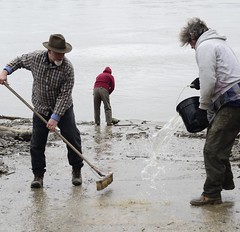 |
| photo by Roxi Pop |
When our crew arrived on the island, it was blowing too hard for us to set up our Flying Nun kitchen tent, so we erected a v-shaped windbreak out of tarps and t-posts. Wishing we had more of both. That little tarp wall saved us, providing a small wind-free space for storage, cooking and hunkering down.
 |
| Our first sunset on the island. Tim led us in a round of Xigong stretches. photo by Steve Schnarr |
Our guests arrive
Getting ready for our new island guests, our first task of the morning was to send a crew back to the ramp to retrieve and deliver the porta-potty. The portable toilet was somewhat of a disputed subject. It was certainly convenient, solved several important problems and even provided a temporary windbreak. But these things are awkward, heavy and in some ways a cop-out for some of our wilderness hardened crew.
And difficult to move by boat.
But we had promised the parents it would be there, so it was really a non-issue. So haul it we did…(its final resting place was about 10 feet from shore right by our landing….that’ll have to do!)
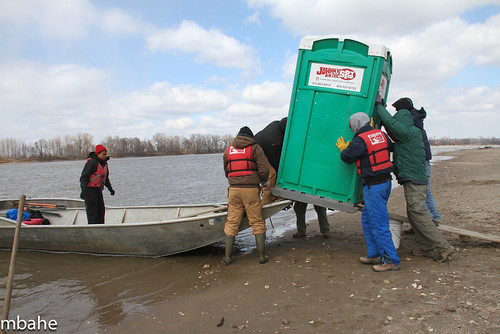 |
| Loading the Porty-Potty. photo by Margaret Bahe. |
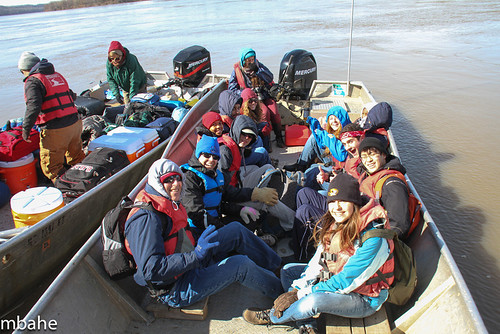 | |
| One boat for gear, one for people. photo by Margaret Bahe. |
We loaded up one boat with gear and the other with passengers and started the shuttle. Landing on the island was tricky. We couldn’t get right up to shore because the slope of the island was too gradual. We laid out our boat benches as ramps to walk to shore through the shallows. It worked great!
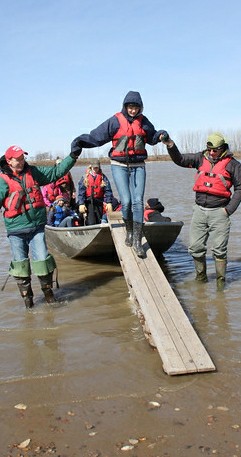 |
| photo by Margaret Bahe |
As the kids started figuring out where they would set up their tents, the wind really picked up. Setting up the tents was both a comedy of errors and a triumph of ingenuity. It took pieces of driftwood, heavy iron poles and a plethora of creative knots and lashings to keep these tents held to the sandbar.
Spring Cleaning on the river
As we all ate lunch, the wind gradually settled down, although never all the way. The students had already divided into groups, each led by one of their talented teachers. One group headed into the woods on the island to scour the forest for trashy flotsam. The others hit the river, targeting what we thought were the most likely trashed spots in the area.
We spent the afternoon getting to know the river and getting to know each other. Everyone was amazed at the kinds of things they found washed up ashore, from toys and furniture to TVs and refrigerators.
And, of course, every plastic item you can imagine. We put in a really solid cleanup set before heading back to camp.
One of the sites we hit was the boat ramp we used to launch our boats and load the students. The ramp is owned by the Warren family, who has lived at the site for more than 150 years. This bend in the river was the Hall’s Ferry, once known as the Musick Ferry. When we arrived at the ramp on Monday, they were already working on clearing the ramp of mud and driftwood logs after the previous week’s rise and drop in the river.
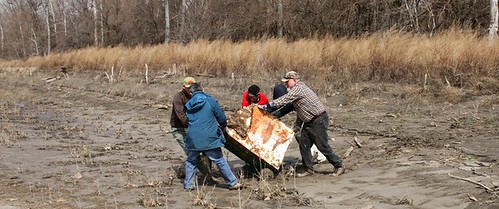 |
| Crews use a dolly to move a refrigerator through the mud. photo by Margaret Bahe. |
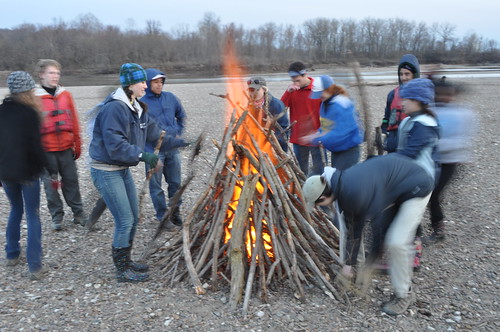 |
| Building the bonfire. Photo by Francis Baum. |
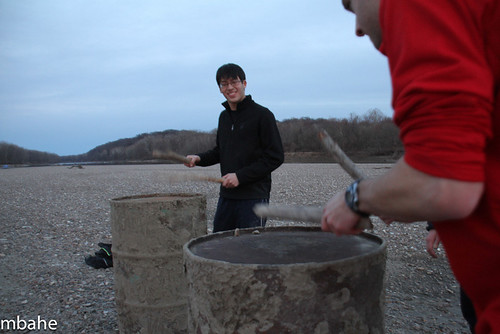 |
| Oil drum percussion on the island. photo by Margaret Bahe |
That pile burned down and we raked the coals into a 20 foot bed. Everyone created “steamboats”: aluminum foil wrapped around a filling of veggies, meat and sauce. Some were swans, some boats, some giant metal rings. When the coals were ready, everyone plopped down their packets at once for a half-hour simmer.
 |
| These kids were fun. photo by Margaret Bahe. |
S’mores (of course) and handwarming commenced. The night turned out relatively pleasant, with diminishing winds and lots of comradeship. But there were a lot of chilly sleepers on Pelican Island that night.
We were so impressed with the crew of kids that came to the river. They worked hard and made the camp work. They were witty, talented, curious and often hilarious. We felt lucky to share the island with this group and wished we had a few more days to get to know them better.
 |
| Camp as the sun was setting. photo by Francis Baum. |
Our River Relief crew was awesome as well. Jodi Pfefferkorn was off the barge, so she joined in. She does the work of four ordinary people, with a sense of humor and a relentless drive. Tim Nigh became the camp host, tidying up our kitchen and organizing the kids into work groups to gather firewood and do clean-ups. Tony Sudekum was amazing, bringing his years of experience doing wilderness expeditions. Francis Baum sacrificed his back for this one…and captured lots of great photos. Melanie Cheney kept rolling with the punches and did an excellent job piloting one of our boats. Roxi Pop documented everything and became that extra hand when we needed it. And Steve Schnarr pretended to know what the plan was…
Here's a really great video put together by Roxi about the entire adventure:
Morning. Break camp and clean up the river.
The wind returned with force in the morning, and stayed with us all day. The kids stoked up the fire and huddled around First thing after breakfast (hot oatmeal and hot cocoa) we broke camp in a swirling sandstorm. Then it was back on the river for more clean-up.
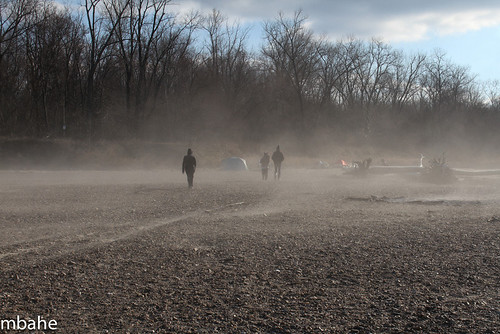 |
| The wind kicked up a sandstorm as we broke down our tents. photo by Margaret Bahe. |
By the time we came back for lunch, we’d put in a good jag of work. But we still had the whole camp to get off the island. Complete and total team work got everything moved down to the beach. An assembly line moved each piece of gear off the sandbar and into the boats. And yes, the porta potty too. Coach Johnson rigged up a clever ramp to slide this sanitary unit up and into the boats…much easier than what we had come up with.
After several back and forth trips, the job was done. All the river trash was disposed of. All the camp gear was stowed. And everyone looked forward to a hot shower at home.
Everyone involved rolled with the punches. Everyone got a unique, deep and direct experience with the river. And everyone left it a much cleaner place. Success!
Alternative Spring Break with John Burroughs Results
Teachers & Students: 29MRR Crew: 6
Boats: 2
River Miles Cleaned: 2 (Rivermiles 15.5 -17.5)
River Level: 14.5 on St. Charles gage
Tires: 14 (.3 tons)
Landfill Tonnage: .9 tons
Scrap Metal: rolled in with landfill
Total Tonnage: 1.2 Total Tons!
Trash Tally!!!!
69 Bags of Trash14 Tires (1 large Truck Tire)
2 Tire Rims
4 Chunks of Syrofoam
2 Coolers
1 5-gal. Plastic Bucket
4 55-gal. Metal Drums
1 55-gal. Plastic Barrel
1 Lawnmower
1 TV
2 Regrigerators
1 Compressor
2 Freezers
2 Old Glass Bottles
Dozens of Balls: Basketball, Football, Softballs
1 Tarp
1 Intake Manifold
9 pieces of Scrap Metal
4 Tomato Cages
1 Shop Vac
1 Bottle of Laundry Detergent
1 piece of Carpet
1 Plastic Lid to a Dumpster
2 Copper Pipes
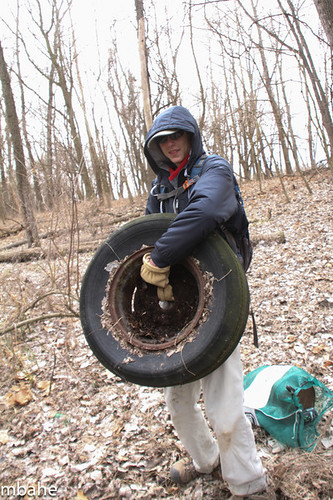


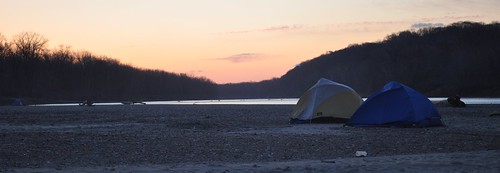

No comments:
Post a Comment